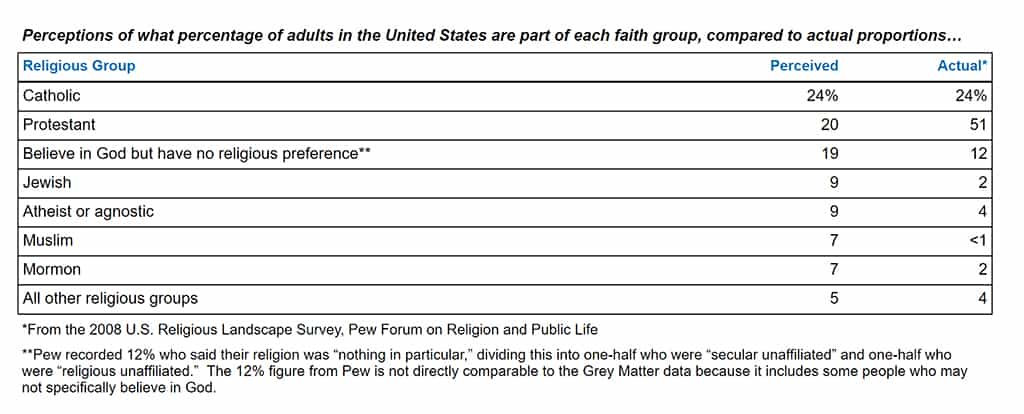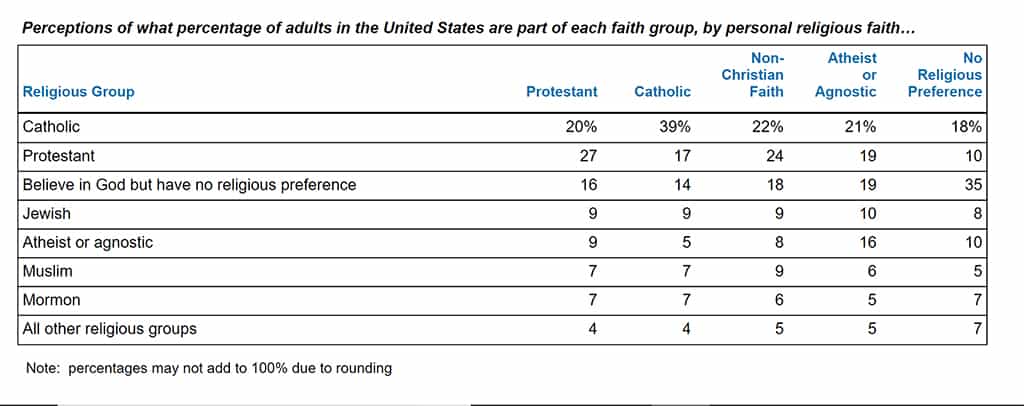Most people dramatically underestimate the proportion of Protestants in the U.S., while seriously overestimating the proportions of Mormons, Muslims, and atheists/agnostics
(Original release date: September 13, 2012) A new study from Grey Matter Research (Phoenix, Arizona) shows the typical American believes the United States is far more religiously diverse than it actually is.
The research was conducted among 747 American adults, and it asked people to estimate what proportion of Americans are part of or affiliated with eight major faith perspectives:
- Protestant (including Baptist, Lutheran, Methodist, Presbyterian, Pentecostal, and all other Protestant groups)
- Catholic
- Jewish
- Mormon
- Muslim
- atheist or agnostic (don’t believe in God or don’t believe we can know whether there is a God)
- believe in God or a higher power but have no particular religious preference
- any other religious group
The typical American adult pegs religious affiliation in the U.S. as follows: 24% Catholic, 20% Protestant, 19% unaffiliated, 9% Jewish, 9% atheist or agnostic, 7% Muslim, 7% Mormon, and 5% from all other religious groups.
In reality, according to the 2008 U.S. Religious Landscape Survey from the Pew Forum on Religion and Public Life, Americans are right on target with the proportion of Catholics and the “all other” category, but way off target on the rest of the landscape.
The typical American badly underestimates how many Protestants there are in the country, and way overestimates the presence of religious minorities such as Mormon, Muslim, and atheist/agnostic.
In the United States, 51% of all adults affiliate with a Protestant belief system, denomination, or church, compared to the average estimate of just 20% in the Grey Matter Research study. In fact, just 12% of all Americans believe Protestants make up at least half of the population in the U.S.
The perception that 24% of Americans are Catholic is exactly what the Pew study found to be the case. But while the average American estimates that 9% of the population is Jewish, only 2% of Americans actually affiliate with the Jewish faith. The typical American estimates that 7% of the population is Muslim, but the real figure is under 1%. Similarly, the estimate is that 7% of the population is Mormon, while in reality it’s about 2%.
Americans also tend to underestimate how many people identify with any religious group in this country. The average estimate in the Grey Matter Research study is that 9% of Americans are atheist or agnostic; the reality (according to Pew) is that just 4% identify themselves as such.
And while the average American feels 19% of the people in this country believe in God but have no religious preference, the reality is that it’s lower than this. According to the Pew study, 12% of Americans are religiously unaffiliated (but not specifically atheist/agnostic), including 6% defined as “secular unaffiliated” and 6% defined as “religious unaffiliated.” Although the definitions are somewhat different between Grey Matter Research and Pew, it is clear that Americans overestimate how many people in the country claim no religious affiliation.
Younger Americans, especially, have a skewed perspective of religion in the U.S. People under age 35 are especially likely to underestimate the proportion of Protestants, and to overestimate the presence of atheists/agnostics and the religiously unaffiliated.
One thing that is clear from this research is that people tend to overestimate the proportion of their own faith group. Among people who identify with the Catholic Church, the average estimate is that 39% of the country is Catholic. Not only is this estimate much higher than it is among non-Catholics, it is far higher than the reality of 24%.
Similarly, among people who identify with a Protestant faith perspective, the average estimate is that 27% of the population is Protestant. While this is far higher than the numbers among non-Protestants, it is still almost half the correct figure.
Among people who identify as atheists or agnostics, the average estimate is that 16% of the American population is atheist or agnostic. As with Catholics, not only is this estimate far higher than among any other group, but it is much higher than the reality. Finally, among people who express no particular faith identification, the average perception is that 35% of Americans believe in God but have no actual religious preference. Again, this is nearly double the average American’s perception, and far higher than the real figure in the U.S.
Ron Sellers, president of Grey Matter Research, noted that there are many potential reasons for this skewed perception of America’s religious landscape. “For one thing, many people don’t really think of ‘Protestant’ as a group. It’s really a compendium of hundreds of individual denominations and independent churches,” Sellers noted. “Smaller faith groups also may be getting disproportionate media coverage, such as Mitt Romney’s campaign bringing the Mormon church into the limelight, or protests over the building of mosques bringing attention to Islam in the U.S. And of course the focus on diversity that’s so popular in this country tends to shine a light on minority groups.”
Sellers also suggested that this skewed perception of religion in America may benefit smaller faith groups and be detrimental to Protestants. “Perceiving a small group as three or four times larger than it really is can lead to that group being seen as more mainstream, with more influence than it actually has. But the reverse is also true. Perceiving Protestantism as little more than a minority faith in this country, even though in reality it’s far larger than any other faith perspective, can diminish the influence and perceived contributions to society of Protestants churches, denominations, and believers.”
Study Details:
The study was conducted by Grey Matter Research, a research and consumer insights company located in Phoenix, Arizona. Grey Matter has extensive experience in research related to faith and spirituality. The sample of 747 adults is accurate to within ±3.4 percentage points at the 95 percent confidence level with a 50 percent response distribution.
The study was conducted in all 50 states using a demographically representative sample from an online research panel. Respondents’ age, education, household income, geography, racial/ethnic background, and gender were carefully tracked and weighted to ensure appropriate representation and accuracy. Non-demographic measures such as religious beliefs and denominational representation were also compared to national norms to confirm representativeness.



